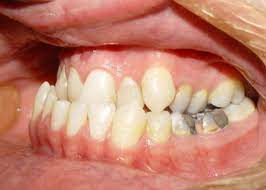Braces: indications, models, when to wear them?
More and more adults are using braces: it is estimated that between 6 and 7% of adults would start an orthodontist treatment. There are several types of devices: bands, gutters... How to choose? How long do you have to wear it? Is it reimbursed? Explanations with Laurent Saada, the dental surgeon.
Definition: what are braces?
Contrary to popular belief, it is possible to have the alignment of your teeth corrected at any age. Nowadays, more and more adults are taking the plunge! Today, they are responsible for more than 47% of orthodontic treatments. " To meet this demand, new types of dental appliances have been developed in recent years, explains Dr. Laurent Saada, dental surgeon. In the collective imagination, dental appliances necessarily include braces, but this does is not true: other types of devices exist today ". We can thus affix the device on the back of the teeth: it acts of the lingual technique. "Better still, we now offer adults transparent gutters made of polyethylene terephthalate. They give results that are as precise as traditional braces,” explains the doctor.
Indications: in which cases to wear it?
" A dental device is necessary in case of anomalies, dental malpositions when there is not enough space between the teeth when teeth overlap when there is a dental-maxillary disharmony or diastema spaces between the teeth … ", explains the doctor. But it is not only a question of realigning the teeth aesthetically speaking: “ it is also a question of ensuring their good function ”, insists the dentist. For example, in cases of malocclusion (when opposing teeth meet badly, because the upper and step jaws do not correlate) or overbite, symptoms may occur: cracking of the jaws, friction between the upper and lower teeth, etc. This can increase the aging of the teeth. In this case, braces are indicated for medical reasons, and so that this defect does not increase.
Who to consult?
" It depends on the case: for a defect that is minor, a dentist with training can treat the problem ", explains the specialist. But of course, " if the case is more complex, we will send the patient to a fellow orthodontist, who is much better able to take care of them".
Which one to choose?
There are several types of appliances to correct dental or maxillary defects:
- the "classic" rings, remain the least expensive but can be embarrassing in life because they are very conspicuous.
- Devices with "multi-ring" or multi-attachment can generally correct everything. There are ceramic ones, less conspicuous, and which do not turn yellow – but the dental floss remains metallic.
- Another technique consists of placing the rings on the back of the teeth: this is the lingual technique. If it hides the device, it is more uncomfortable for the tongue, and it is contraindicated when the teeth are too short. It should also be noted that these three types of devices must remain in place throughout the duration of the treatment, without being able to be removed.
- Therefore, in order to meet the demand of adult patients, new types of invisible and removable dental appliances have been developed. " These are disposable gutters, in transparent plastic, made with the patient's teeth impressions. We send the prints to the United States (because they are the ones who have the patent) and with a special technique, a computer calculates how many gutters and how long of treatment (12 months, 18 months, 24 months …) the patient will need to put the teeth back in their initial position of alignment, explains doctor Laurent Saada. Then the patient receives all the aligners he will need, which are numbered, and he will have to change them every 15 days or every month with the next one to properly align the teeth, "he describes. The advantage is that they can be removed at mealtimes and when brushing your teeth." Once all the gutters have been used, you have the desired result, knowing that this gutter must be worn at least 20 hours out of 24 per day ". these devices cannot treat too complex cases, and in some cases, surgery may also be necessary.
Duration: how long to wear it?
The time needed to realign the teeth depends on many factors: the type of appliance and the complexity of the problems. " In the fastest cases, it's 6 months, but the treatments can last up to 24 or 30 months ". Once finalized, it is of course necessary to consolidate the result, because the teeth move again. "It is, therefore, necessary to set up a retainer, which is worn at night, or a retainer wire: it is a metal wire placed on the lingual surface of the teeth ". This is kept permanently and allows the alignment to be maintained over time.
Is it painful?
The installation of dental appliances is less painful today than in the 2000s because the techniques have evolved: the rings are miniaturized and less unpleasant, the wires are more flexible and generally better supported. " It's obviously painful at the start since you put an effort on the teeth, but it's still very bearable. It will pull for a day or two, during the break and each time you readjust ".

No comments